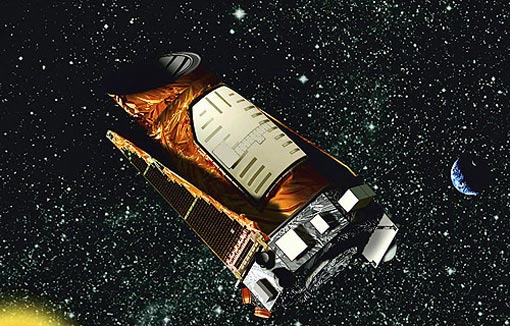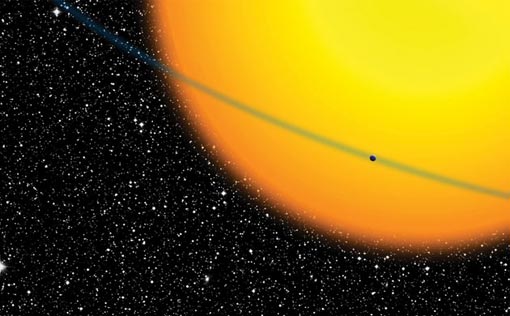You are hereWcP.Scientific.Mind's blog
WcP.Scientific.Mind's blog
Satellite solar panels in orbit to capture sun's rays 24/7 & wirelessly beam energy down to Earth

(quote)
Pacific Gas and Electric, which serves San Francisco and northern California, is to seek approval to buy 200 megawatts of energy from solar power firm Solaren. Within seven years, Solaren plans to send a satellite equipped with solar panels around 22,000 miles into space on board a conventional rocket.
Satellite solar cells would capture the sun’s rays 24 hours a day, without fear of cloudy mornings or dark nights. The orbiters then convert this solar power to radio-frequencies that transmit to ground stations in Fresno County, Calif. Once received, the radio energy would change into electricity and flow into the grid.

Sunlight in space is at least ten times more powerful than that on Earth, making orbiting solar panels far more efficient than those which are land-based. Solaren believes the technology could provide enough clean electricity to power at least 150,000 Californian homes.
(unquote)
Images courtesy of Mafic Studios and Newscom read more »
On Mar 2, 1969 world's first supersonic jetliner Concorde took flight, feat of collaboration eng. & work of beauty

(quote)
It was a feat of engineering and a work of exceptional beauty and grace. It won the hearts and minds of millions of people.
Forty years ago today the supersonic Concorde took its first test flight, and a design paragon flashed across the skies over Toulouse. With its droop nose and delta wing, the Concorde was a high point of 20th century engineering (its maiden flight came three months before the first moon landing) and the kind of cooperative effort that now seems beyond us. As we enter a period of infrastructure spending, it’s worth noting what kept the Concorde aloft for 27 years.
NASA's spacecraft Kepler blasts off on a three-year mission in search of Earth-like planets

(quote)
NASA's Kepler spacecraft blasted off from Kennedy Space Center in Florida on Friday on a three-year mission to find Earth's twin, a Goldilocks planet where it's neither too hot nor too cold, but just right for life to take hold.
The Delta II rocket, carrying the widest field telescope ever put in space, lifted off the launch pad at Cape Canaveral at 10:49 p.m. Eastern time. The launch vehicle headed down-range, gathering speed as its three stages ignited, one after the other, passing over Antigua Island in the Caribbean and later over tracking stations in Australia before climbing into orbit.

Kepler will eventually settle down to scan tens of thousands of stars near the constellations Cygnus and Lyra in search of planets where water could exist on the surface in liquid form, a key condition for life as we know it. "We have a feeling like we're about to set sail across an ocean to discover a new world," said project manager Jim Fanson of the Jet Propulsion Laboratory in La Cañada Flintridge. "It's sort of the same feeling Columbus or Magellan must have had." read more »
MIT Solar Electric Vehicle Team unveils sleek 90-mph car, will compete in World Solar Challenge in Australia

(quote)
MIT's Solar Electric Vehicle Team, the oldest such student team in the country, has just finished construction of its latest high-tech car and unveiled it to the public this Friday. "It drives beautifully," said George Hansel, a freshman physics major at the Massachusetts Institute of Technology and a member of the team. "It's fun to drive and quite a spectacle." With six square meters of monocrystalline silicon solar cells and improved electronic systems and design, the car can run all day on a sunny day at a steady cruising speed of 55 mph. The car will be competing in October in the World Solar Challenge race across Australia, and in preparation for that the team plans to drive the car across the United States over the summer. About a dozen team members are expected to go to Australia for the race, although only four will drive the solar car in the competition.
Snowflakes are science and art: see ice crystals, simple, complex, the basics behind these miniature miracles of Nature

(quote)
Caltech physics professor Kenneth G. Libbrecht has turned his passion for the study of ice crystals into an art form. In his books and website, snowcrystals.com, he breaks down some of the basics behind these miniature miracles of nature
Stellar Plates
These common snowflakes (above) are thin, plate-like crystals with six broad arms that form a star-like shape. Shapes like these form around 28 degrees Fahrenheit, while columns and slender needles appear near 23 degrees. Plates and stars again form near 5 degrees Fahrenheit.

Simple Prisms
Snowflakes are not frozen raindrops (that is better known as sleet). They form when water vapor condenses directly into ice, which happens in the clouds. In their most basic form, snow crystals are hexagonal prisms like the sample, above, but other, more complex forms are famously possible.

Sectored Plates
The simplest sectored plates are hexagonal crystals that are divided into six equal pieces, like the slices of a pie. More complex specimens show prominent ridges on broad, flat branches.
Ocean Mysteries: 'Immortal' jellyfish from Caribbean capable of reverting to younger self spreading all over world

(quote)
Marine biologists say the jellyfish numbers are rocketing because they need not die. Dr Maria Miglietta of the Smithsonian Tropical Marine Institute said: "We are looking at a worldwide silent invasion."
The jellyfish are originally from the Caribbean but have spread all over the world. Found in warm tropical waters Turritopsis is believed to be spreading across the world as ships’ ballast water is discharged in ports.

Turritopsis Nutricula is technically known as a hydrozoan and is the only known animal that is capable of reverting completely to its younger self. It does this through the cell development process of transdiff- erentiation. Scientists believe the cycle can repeat indefinitely, rendering it potentially immortal.
Though solitary, they are predatory creatures and evolve asexually from a polyp stage. While most members of the jellyfish family usually die after propagating, the Turritopsis nutricula has developed the unique ability to return to a polyp state. read more »
25 years of innovation: Apple's unveiling of the first Macintosh forever changed the future of personal computing

(quote)
The Macintosh - the first to bear the name - turns 25 on 24 January. The machine debuted in 1984 and kicked off a product line that were Apple's flagship computers for many years.
The Macintosh helped popularize the combination of graphical interface and mouse that is ubiquitous today. It had a revolutionary all-in-one design, and crucially, used a graphical user interface to navigate around, rather than text commands. This enabled the Apple Macintosh to cross the species barrier – everyday users could now use the computer, rather than just geeks au fait with scripting and coding. Indeed, the $2,495 price tag was perhaps the only barrier to entry.

The mouse input system and simple GUI enabled users to carry out a range of tasks that had been impossible on other computers. The Apple Macintosh came bundled with two software programs, MacWrite and MacPaint, signalling the birth of word processing and desktop publishing. With just 128KB of memory and a sloth-like 8MHz processor, the Apple Macintosh is woefully underpowered by today’s standards, but was cutting edge at the time. read more »





















